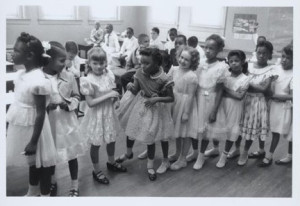 Desegregation of the Baltimore City Public School System happened in 1956 after the United States Supreme Court ruled, in the case of Brown v. Board of Education, that segregation in schools went against constitutional law. Desegregation of American schools was a pivotal part of the civil rights movement, as no progress in the civil rights movement would have been made if America’s schools remained segregated.
Desegregation of the Baltimore City Public School System happened in 1956 after the United States Supreme Court ruled, in the case of Brown v. Board of Education, that segregation in schools went against constitutional law. Desegregation of American schools was a pivotal part of the civil rights movement, as no progress in the civil rights movement would have been made if America’s schools remained segregated.
Following the Supreme Court ruling cities all across America began to desegregate. Baltimore, the largest city in the state of Maryland, desegregated all its public schools following the Supreme Court’s decision, and the events that followed the desegregation in Baltimore, were both interesting and important to the civil rights movement across America. Recent scholarship has begun to revisit the importance of the desegregation of Baltimore’s public schools and identify it as an important precursor to the Greensboro sit-ins.
Most Baltimore City public schools were not integrated until after the Supreme Court decision in Brown v. Board of Education. However, in 1952 Baltimore Polytechnic Institute was forced to open its advanced college preparatory curriculum to African American students. This course was prestigious and was unusual for a high school at that time. The Institute’s so-called “A” course included calculus, analytical chemistry, electricity, mechanics and surveying; subjects not offered at the black schools in the City at that time. The Institute was a whites-only school but supported by both white and black tax dollars. Consequently a group of 16 African American students, along with help and support from their parents, the Baltimore Urban League and the National Association for the Advancement of Colored People (NAACP), applied for the engineering “A” course at the Institute. The applications were denied and the students sued.
The subsequent trial on the suit began on June 16, 1952. The NAACP’s intentions were to end segregation at the 50-year-old public high school. They argued that the Institute’s offerings of specialized engineering courses violated the “separate but equal” clause because these courses was not offered in high schools for black students. To avoid integration, an out-of-court proposal was made to the Baltimore City school board to start an equivalent “A” course at the colored Frederick Douglass High School.
]
The hearing on the “Douglass” plan lasted for hours with Dehuff and others arguing that separate but equal “A” courses would satisfy constitutional requirements and NAACP attorney Thurgood Marshall arguing that the plan was a gamble and cost the City should not take. By a vote of 5-3, the board decided that a separate “A” course would not provide the same educational opportunities for African American students and that starting that fall, African American students could attend the Institute. The vote vindicated the NAACP national strategy of raising the cost of ‘separate but equal’ schools beyond what taxpayers were willing to pay.
The African American population in Baltimore before 1954 was significant, and rose dramatically after the schools were desegregated. (Crain 1968, 72) This is not to say, however, that the desegregation of Baltimore schools went smoothly. There were many problems encountered along the way to a free and equal school system and society in Baltimore, Maryland.
Because of the rapid growth of the African American community in Baltimore, the schools became over crowded. Due to the over crowding of the schools, Baltimore decided to district the schools. (Crain 1968, 74) This means that if someone did not live in the district of a certain school, they could not attend that school. This was a way for the school system to remain segregated. African Americans and whites still lived in different areas of Baltimore, therefore, African American and white children went to different schools. Obviously desegregation had not taken full effect.